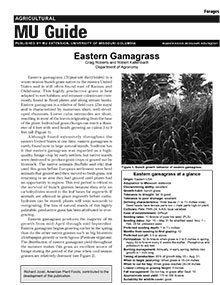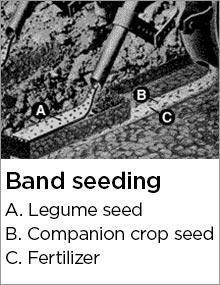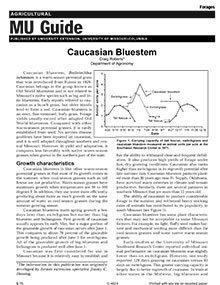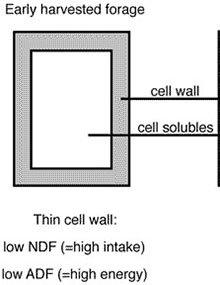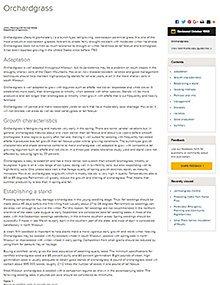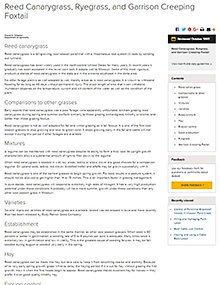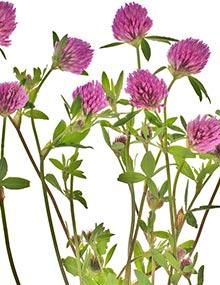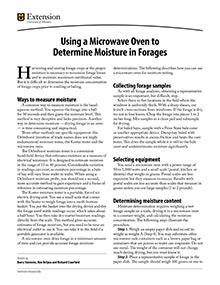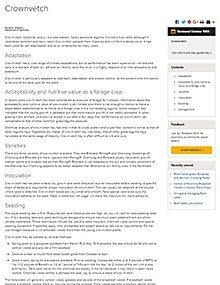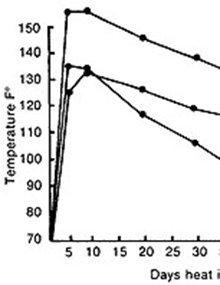The following publications cover topics related to Forages. For a complete list of MU Extension publications, visit the main Publications page.
Eastern Gamagrass
Reviewed
Eastern Gamagrass is a highly productive grass and is a high-quality forage crop. Visit our website today to learn more.
Establishing Forages
Reviewed
Avoid forage seeding failures by using research-proven procedures. Seeding failures are costly, not only in seed and labor cost, but in providing inadequate feed the following year.
Caucasian Bluestem
Reviewed
Warm-season grass known for drought tolerance, high forage yield, and ease of establishment; less ideal for wildlife than native alternatives.
Using NDF and ADF to Balance Diets
Reviewed
Estimate forage intake and energy values for cattle diets using NDF and ADF measurements to optimize animal performance and feed efficiency.
Orchardgrass
Reviewed
Orchardgrass is a cool-season perennial grass well-suited for Missouri, offering early spring growth, shade tolerance, and compatibility with legumes.
Corn Silage
Reviewed
Corn silage is a popular forage for ruminant animals because it is high in energy and digestibility. Visit our site to learn more about corn silage.

Birdsfoot Trefoil
Reviewed
Birdsfoot trefoil is a long-lived perennial legume ideal for Missouri pastures, offering summer forage, bloat-free grazing, and higher livestock gains.
Reed Canarygrass, Ryegrass, and Garrison Creeping Foxtail
Reviewed
Reed canarygrassReed canarygrass is a tall-growing, cool season perennial with a rhizomatous root system (it roots by sending out runners).
Forages for Cattle: New Methods of Determining Energy Content and Evaluating Heat Damage
Reviewed
This guide offers practical advice on selecting and managing cover crops for grazing, focusing on species choice, timing, and economic considerations.
Red Clover
Reviewed
Red clover is the most widely grown of all the true clovers. Visit our website today to learn more about red clovers.
Establishing Birdsfoot Trefoil in Bluegrass Sod
Reviewed
Birdsfoot trefoil and Kentucky bluegrass will produce three times as much beef as unimproved bluegrass. Even heavily fertilized bluegrass will produce only 65 percent as much animal product as trefoil-bluegrass combination. See Table 1.
Using a Microwave Oven to Determine Moisture in Forages
Reviewed
Determine forage moisture content accurately using a microwave oven with this step-by-step guide, ensuring optimal harvest and storage conditions.
Crownvetch
Reviewed
Crownvetch, Coronilla varia L., is a cool season, hardy, perennial legume. It is not a true vetch, although it resembles common and hairy vetch. Crownvetch spreads from rhizomes and will form a dense cover. It has been used for soil stabilization and as an ornamental for many years.
Alfalfa
Reviewed
Alfalfa is the most productive legume for Missouri. Visit our website today to learn more about Alfalfa.
Making and Storing Quality Hay
Reviewed
Properly making and storing hay and greatly reduce dry matter loses. Visit our site to learn about Making and Storing Quality Hay.
The Bluegrasses
Reviewed
White, Ladino and Sweet Clover
Reviewed
White and ladino clover varieties offer high-quality forage, nitrogen fixation, and adaptability to cool, moist conditions, but require careful grazing management.
Tall Fescue
Reviewed
Tall Fescue is one of the more drought-resistant field plants grown in Missouri. Visit our website today to learn more.
Renovating Grass Sods With Legumes
Reviewed
Enhance pasture productivity by integrating legumes into grass sods using cost-effective methods that boost forage quality, animal gains, and soil fertility.
